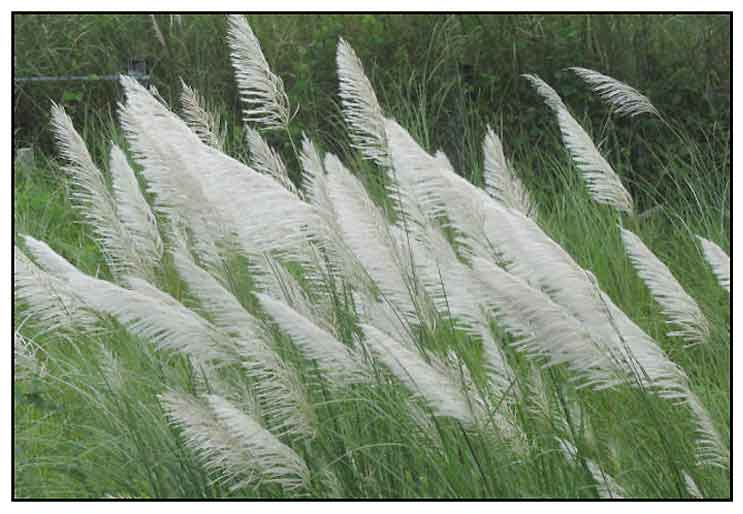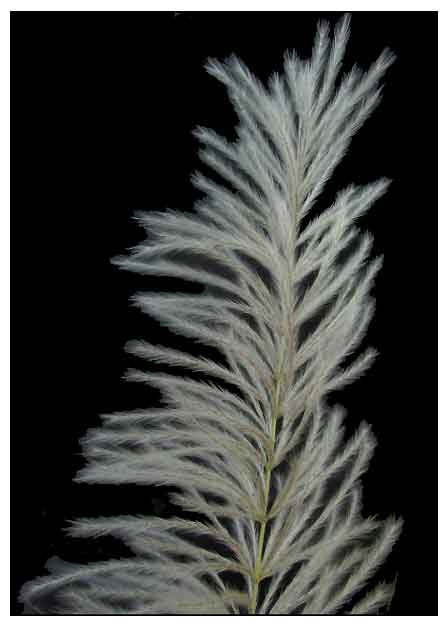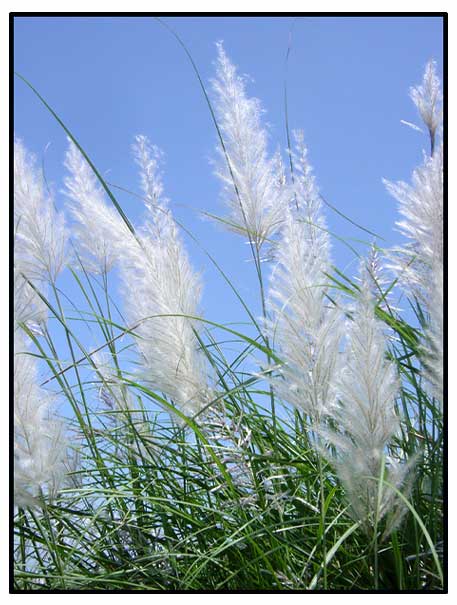|

Gen info
- Saccharum is a genus of tall perennial plants of the broomsedge tribe within the grass family.
- Saccharum includes the sugarcanes. All sugarcane species interbreed and the major commercial are complex hybrids.
(43)
- Etymology: The genus name Saccharum is derived from Greek word 'saccharon' meaning 'sugar or sweet juice', referring to the sugarcane genus. The specific epithet spontaneum means 'spontaneous',
referring to the plant's fast growth and ability to readily colonize disturbed areas. (44)
 Botany Botany
• Talahib is a coarse, erect,
perennial grass, usually more or less tufted, with stout underground rootstock, growing to
a height of 1 to 3.5 meters. Leaves are harsh and linear, 0.5
to 1 meter long; 6 to 15 millimeters wide. Panicles are white and erect,
measuring 15 to 30 centimeters long, with slender and whorled branches, the
joints covered with soft white hair. Spikelets are about 3.5 millimeters long, much shorter than the copious, long, white hairs at the base.
• Growth form: Tall perennial clumping grass, up to 4m height, with erect habit, deep roots and long spreading rhizomes. Secondary genetic relative of sugarcane. Foliage: Leaf blades linear, green with white midrib, margins finely serrated and prickly. Culms (leaf stalks) slender, fibrous with little juice, arranged in small clumps, 1-4m tall, turning brown or black when mature. Flowers: Spikelets of florets with long silky white hairs, borne in branching panicle inflorescences (20-60cm tall) that typically tower above the rest of the plant. Plume branches ascending and often tinged reddish or purplish. Blooms towards end of rainy season in native range. Fruit: One-seeded caryopsis grains (1.5mm), tufted and dispersed by wind. (44)
Distribution
- Native to the Philippines.
-
In open areas at low and medium altitudes, ascending to 1,500 meters, often gregarious, occupying large areas throughout the Philippines.
- Afghanistan, Algeria, Andaman Is., Assam, Bangladesh, Bismarck Archipelago, Burkina, Cambodia, Cameroon, Central African Republic, Chad, China North-Central, China South-Central, China Southeast, East Himalaya, Egypt, Eritrea, Ethiopia, Ghana, Gulf States, Hainan, India, Japan, Jawa, Kazakhstan, Kenya, Kirgizstan, Korea, Laos, Lebanon-Syria, Lesser Sunda Is., Libya, Malawi, Malaya, Maluku, Morocco, Myanmar, Nansei-shoto, Nepal, New Guinea, Nicobar Is., Niger, Nigeria, Northern Territory, Oman, Pakistan, Palestine, Queensland, Saudi Arabia, Seychelles, Sicilia, Sinai, Solomon Is., Somalia, Sri Lanka, Sudan, Sumatera, Tadzhikistan, Taiwan, Tanzania, Thailand, Tibet, Togo, Tunisia, Turkmenistan, Uganda, Uzbekistan, Vietnam, West Himalaya, Xinjiang, Yemen. (15)
 Constituents Constituents
- Phytochemical screening of stem extracts yielded quinones, terpenes, alkaloids, flavonoids, saponins, tannins, carbohydrates, protein, coumarin, phenol, steroids and glycosides. (3)
- Various root extracts yielded terpenoids, steroids, glycosides, tannins, flavonoids, carbohydrates. (9)
- Total phenolic content was 351.25 ± 1.31 µg in the ethanol extract, 254.42 ± 1.82 µg GAE in the water fraction.
Flavonoid content of root ethanolic and water extract was 48.60 ± 2.17 µg and 38.59 ± 2.10 µg rutin. (28)
- Phytochemical screening of aqueous leaf extracts yielded tannins, quinones, terpenoids, steroids, flavonoids, phenols, alkaloids, cardiac glycosides, coumarins, betacyanin, with absence of saponins, glycosides, and anthocyanins.
- Qualitative phytochemical analysis of water and alcohol extracts of stems yielded: quinone, alkaloids, tannins, carbohydrates, protein, coumarin, phenol, and steroids. Only alcohol extracts yielded terpenes and glycosides, while the water extracts yielded saponins. Both extracts were negative for
gum and flavonoids. (41)
Properties
-- Potential as serious invader of cultivated land, often resulting in abandonment.
Known to reduce productivity of some crop species like wheat, tea, rubber, sugarcane. Also, it is a host to a large number of pests and diseases, acting as reservoir for spread into adjacent crops. (35)
-
In Ayurveda, roots are considered sweet, astringent, emollient, refrigerant, diuretic, lithotriptic, purgative, tonic, aphrodisiac. (1)
- Studies have suggested antimicrobial, cytotoxic, antioxidant, CNS depressant, anti-psychotic, antiuroliithiatic, antidiarrheal, phytoremediative, anti-inflammatory, anti-obesity, antidiabetic properties. (37)
Parts used
Roots, leaves, stems.
Uses
Edibility
- In Indonesia, young shoots boiled and eaten with rice (Uphof, 1968). (26)
Folkloric
- In the Philippines decoction of the roots used
as a diuretic.
- Decoction of roots used for fever.
- In the Ayta communities in Dinalupihan, Bataan, Philippines, decoction of leaves and roots drunk for colds, cough, spasms, and fever; also used to increase lactation.
- Warmed poultice of the stem pulp applied to painful areas in the leg and in cases suffering from beri beri.
- In Iloilo, used for treatment of gastrointestinal disorders. (40)
- In Pakistan, used as laxative, phthisis,
burning sensations and disease of the blood.
- In Bengal, roots used as galactagogue and diuretic.
- Rural people in Vellore district of Tamilnadu and Andhra Pradesh use the fresh juice of stem for treatment of mental illness and mental disturbances.
(1)
- In Ayurveda, used for dyspepsia, piles, sexual weakness, respiratory problems and gynecological troubles. Roots considered astringent, emollient, refrigerant, diuretic, lithotriptic, purgative, tonic, aphrodisiac.
- In Bengal, roots used as galactagogue and diuretic. (1)
- Used for teeth whitening.
- In Siddha, the whole plant is used for diseases of vatam and pittam, vomiting and various abdominal disorders, mental diseases, dyspnea, anemia and obesity.
In Uttar Pradesh, paste prepared from equal quantities of fresh roots of Cynodon dactylon and Saccharum spontaneum is given with cow's milk and sugar for leucorrhea, early morning for one month.
- In Bangladesh, used for treatment of diabetes.
(•)
Others
- Fodder: A coarse grass not favored by cattle; grazed on only in times of scarcity. Reported as good fodder for goats and camel and suitable for production of silage. (26)
- Weaving / Rope: Provides good thatching material. Used in production of ropes, mats, and brooms. (26)
Stem used to weave minnowing trays used to separate chaff from grain. Inflorescence used for roof thatching. (32)
- Revegetation and Restoration Programs: Has attracted attention
for its potential in ecological restoration.
(see study below) (27)
- Paper making: A source of material with lower extractives and lignin content, higher holocellulose content and a pulp of high brightness ceiling.
(6)
Studies
• Phytochemicals: Screening yielded the presence of quinines, alkaloids, tannins, carbohydrates, protein, coumarin, phenol, steroid and glycosides.
• CNS Depressant / Antipsychotic Activity: Study in rats showed reduction in motor activity, more pronounced in the ethanol and aqueous extracts. The aqueous extracts showed mild antipsychotic activity. The psychopharmacologic effects were attributed to the alkaloids, tannins, steroids and glycosides.
• Antimicrobial / Cytotoxic / Antioxidant: Chloroform extract showed antioxidant activity with IC50 value of 51.04 ug/ml (vs ascorbic acid 41.04). Crude extract showed cytotoxic activity using Brine shrimp lethality assay with LC50 of 6.63 ug/mL (vincristine 10.64). Antimicrobial activity was exhibited against gram-positive and gram-negative pathogenic bacteria and against three tested fungi. (2)
• Antimicrobial / Trinpanchmool / Herbal Combination: Study on the antimicrobial activity of trinpanchmool drugs - a combination of Kush (Desmotachya bipinnata), Darbh (Imperata cylindrica) and Kas (Saccharum spontaneum) showed promising antimicrobial activity against different microorganisms (gram-positive, gram negative and fungal strains). The drugs in combination were more active than individual extracts. (14)
• Pulp and Paper Making: Study showed S. spontaneum is a bulky material with lower extractives and lignin content and higher holocellulose content with a good response towards multistage bleaching sequence and a pulp of high brightness ceiling. (6)
• Cellulase Production: Study showed S. spontaneum can be utilized as a substrate in solid state fermentation for economic production of cellulase. Cellulases are the third largest industrial enzyme in the world. (8)
• Antioxidant Activity / Roots: Study of extracts of S. spontaneum roots showed antioxidant activity similar to standard drugs used in the experiment. Methanolic extracts showed higher phenolic and flavonoid content. (10) Study evaluated the in vitro antioxidant activity inhibition of superoxide, NO, OH, reducing power assay and total antioxidant capacity. Results showed the root extract has potential to scavenging free radicals and a good antioxidant for treating various diseases. (30)
• Antiurolithiatic Activity: Study evaluated an ethanolic extract of roots for preventive effects on calcium oxalate calculi in rat. Results showed urinary stones could be dissolved with the extract and recurrence could also be prevented. The antiurolithiatic activity was attributed to the ability to reduce the supersaturation of urine with calculogenic ions, diuretic property, and antioxidant potential. (11) Study evaluated an ethanolic extract of whole plant for antiurolithiatic activity against calcium oxalate stone induced by rats fed with a calculi-producing diet. Results showed potential as curative agent for urolithiasis. (19) Study showed an ethanolic extract of roots has curative effect on stone formation in rats with lithiasis induced by ethylene glycol. (22) Study evaluated an alcoholic extract of S. spontaneum in albino rats with lithiasis induced by a calculi--producing diet with 3%-glycolic acid. Treatment showed significant amelioration to near normalcy, with increase in urine volume and reduction of tendency for crystallization. (33)
• Antibacterial / Leaves and Roots: Study investigated the antibacterial property of extracts of leaves and roots against Staphylococcus aureus. Results showed the root extract to have a significant effect on S. aureus. (12) Study evaluated the antibacterial potential of S. spontaneum against human pathogenic bacterial strains. Whole plant extracts showed significant zone of inhibition against S. aureus, S. pneumoniae, B. cereus, B. pumilus, E. coli, K pneumonia, P. aeruginosa and C. freundii. (18)
• Saccharum Spontaneum Biomass for Releasing Reducing Sugars: Kans grass (Saccharum spontaneum), a perennial grass native to South Asia, is a low cost, renewable and prevalent source of reducing sugars. Study investigated the effect of H2SO4 concentration, biomass loading and reaction time for releasing reducing sugars from the grass. Results showed that under controlled conditions Kans grass biomass can be effectively utilized as a potential source of reducing sugars, which can be used as starting material for production of various chemicals by microbial conversion process. (13)
• Potential as Laundry Detergent / Roots: Study evaluated the potential use of S. spontaneum as laundry surfactant for removing clothes stains. Results showed the surfactant to be capable of removing stains with more efficiency than commercial products, and ecofriendly to boot. (16)
• Acute and Subacute Toxicological Studies: Study evaluated the toxicity of ethanol root extract of S. spontaneum on male Wistar albino rats. On acute toxicity testing, no mortality was seen at doses of 50, 150, 300, 500, 1000, and 2000 mg/kbw, indicating a high margin of safety. On sub-acute toxicity testing, in doses varying from 100 - 500 mg kbw for 28 days, results showed no alterations in hematological and biochemical parameters and suggest a potential safe alternative for various severe infections. (17)
• Denitrification of Drinking Water: There is a global concern regarding the increasing pollution of natural water bodies by nitrate secondary to anthropogenic activities. Results showed the potential to obtain high yields of denitrification using organic carbon released from S. spontaneum. Study results contribute to the knowledge on the use of NOSS (natural organic solid substances) as alternative sources of carbon for denitrification. (20)
• Anti-Obesity: Study investigated the anti-obesity effect of ethanol extract of S. spontaneum in male Wistar strain albino rats. Results showed the whole plant extract exerted significant anti-obesity activity in rats fed with a high fat diet. (21)
• Antidiarrheal / CNS Depressant: Study of S. spontaneum for antidiarrheal activity in castor oil induced diarrhea in mice showed a dose dependent decrease in the total number of faecal droppings. In an evaluation for CNS effects, depressant activity was showed with dose dependent reduction of the onset and duration of pentobarbitone-induced hypnosis, reduction of locomotor and exploratory activities in open field and hole cross tests. (23)
• Biodiesel: Study showed Talahib grass at full maturity can produce 18 to 28% oil which can be converted to biodiesel by a processor at 100% yield. (24)
• Removal of Municipal Waste Water: Study showed the although municipal waste water inhibit the growth of aquatic plants (T. patifolia and S. spontaneum), these plants have the potential for use in the phyto-reduction process of COD, BOD, and TSS from wastewater. (25)
• Potential for Ecological Restoration: Study reports on the potential for S. spontaneum for restoration and stabilization of fly ash (FA) dumps. The plant has potential as ecological tool in restoration of vast tracts of fly ash dumps. (27)
• Qualitative / Nutritional Analysis of Roots: Root is utilized as food. Phytochemical screening of ethanolic and water extracts of root powder yielded carbohydrate, glycoside, protein, tannins, flavonoids, and terpenoids. Study suggests potential of the plant to provide mental health benefits, including disease treatment and prevention. (see constituents above) (28)
• Anti-Inflammatory / Cream Formulation / Roots:Study evaluated a root extract and 2% pre-formulated cream for antibacterial activity and anti-inflammatory activity. It showed no zone of inhibition against three test microorganisms i.e., Staphylococcus aureus, S. epidermis, and Pseudomonas aeruginosa. It showed anti-inflammatory activity in carrageenan induced inflammation in a mice model. (29)
• Adsorption of Azodye Titan Yellow: Study reports on the use of S. spontaneum for the removal of industrial dye (Titan yellow) from aqueous solution. (34)
• Hypolipidemic / Whole Plant: Study evaluated the effect of ethanolic extract of Saccharum spontaneum whole plant in attenuating hyperlipidemia induced in rats fed with an atherogenic diet. Oral administration of ethanol extract of whole plant significantly lowered the TC, TG, and LDL-C levels, along with an increase in HDL in a dose dependent manner. Activity was attributed to the presence of antioxidant phenolic compounds. (36)
• Antioxidant / Leaves: Study evaluated the antioxidant activity of ethanolic extract from leaves of S. spontaneum. Single-factor ANOVA showed a significant difference between different concentrations (40, 70, and 90%) of ethanol extract of leaves and commercially available ascorbic acid. There was a positive correlation on average absorbance of different concentrations of talahib leaves extract, i.e., as the amount of talahib extract increases, the absorbance rate increases as well. The lowest concentration (40%) gave the highest absorbance rate of DPPH assay i.e. highest antioxidant activity. Study suggests potential for a tablet formulation. (38)
• Green Composites Reinforced with S. spontaneum Fiber and Graft Polymers: Study reports on the preparation of corn starch based green composites reinforced with graft copolymers of S. spontaneum fiber and methacrylates (MMA) and its mixture with acrylamide (AAm), acrylonitrile (AN), acrylic acid (AA). Results showed S. spontaneum fiber-reinforced composites exhibited better tensile strength. Ss-g-poly (MMA) reinforced composites showed maximum compressive strength and wear resistance. (39)
• Antidiabetic: Study evaluated the antidiabetic effect of ethanolic extract of S. spontaneum on STZ-induced diabetic mice. Results showed significant decrease in glucose level, slight enhancement of body weight after treatment. Daily oral treatment of extract also showed reduction of serum ALT, creatinine, and triglyceride compared to diabetic control. Results suggest potential source of antidiabetic agent. (45)
• Effect on Lysosomal Enzymes in Urolithiasis / Root: An ethanolic root extract was used to treat urolithiasis induced by glycolic acid. The extract also repaired changes in lysosomal enzymes like
ß-D-glucoronidase, xanthine oxidase in liver and kidney and n-acetyl-d-glucosaminidase in serum, liver, kidney, and urine of erolithiatic rats. Results showed the ethanolic root extract (200 and 300 mg/kbw) showed potent antiurolithiatic activity, with no significant different (p<0.05) to standard thiazide drug treated group. (46)
• Nanofiber Synthesized with Egg Shell Particulated Polyester Resin: Study evaluated the mechanical behavior of saccharum spontaneum fiber in associated with unsaturated polyester resin. The saccharum spontaneum fiber was extracted from the leaf of the plant, and the fiber taken as nano particles. Egg shell particles were used as filler by hand layup process. When fiber content was increased in the composition the tensile strength is gradually increased. The egg shell contributed a great part to the impact strength of the composite. The synthesized nanocomposite compound was investigated against gram-positive bacteria (S. aureus and B. subtilis), gram-negative bacteria (E. coli and P. aeruginosa), and two fungi strains (A. niger and C. albicans) by modified well diffusion method. Biological data revealed the synthesized composite has significant biologic activities. (47)
• Biosorbent for Removal of Methylene Blue: Saccharum spontaneum is used as no-cost scavenger to arrest methylene blue, a recalcitrant dye from colored effluent. FTIR hghlights the presence of polyphenolic and carboxylic moieties. Industrial effluent analysis suggests real-time removal of ~55% in the first cycle. Study suggest S. spontaneum could be exercised to solve environmental problems related to colored water. (49)
Availability
Wild-crafted. |


![]()

